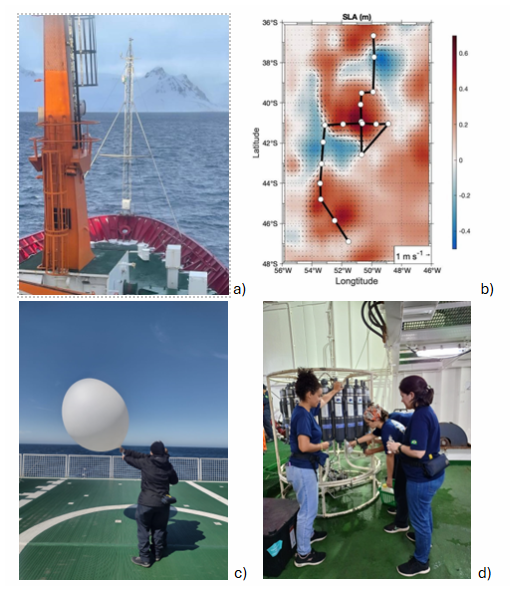First fieldwork of “Antarctic Modeling and Observation System 2" - ATMOS 2

The Brazilian Antarctic Program (PROANTAR) is committed to producing scientific knowledge about the global climate system, involving the connections of the atmosphere and the ocean with emphasis on the Southern Ocean, the cryosphere, and the biosphere. This is a Brazilian state program where the Antarctic Modeling and Observation System 2 (ATMOS 2), the second stage of the ATMOS project, is funded and supported. This is still an innovative initiative that contributes to the integrated understanding of the dynamic and thermodynamic processes associated with the interaction of sea ice-ocean-atmosphere-waves at micro, meso, and large scales in the Atlantic sector of the Southern Ocean. One of the major concerns of ATMOS 2 is to study and deepen knowledge about the exchanges that occur through turbulent fluxes of heat, momentum, and CO2 at this interface. In the context of CO2 fluxes, the Climate Change and CO₂ Exchanges from Brazil to Antarctica (BIOMAR CO2) project works in partnership with ATMOS 2, investigating how physical and biogeochemical mechanisms modulate the CO2 fluxes along the ship's track from Brazil to Antarctica. BIOMAR CO2 is funded by Serrapilheira Institute which offered a special credit line to support black and indigenous early-career scientists.
In 2024, ATMOS 2 and BIOMAR CO2 have accomplished the first and second phases of Brazilian Antarctic Operation 43 (OP43). In the first phase, the in situ data were collected on board the Brazilian Navy Polar Vessel (Po/V) Almirante Maximiano (H-41) during the ATMOS 2 cruise. Along H-41’s track, turbulent heat fluxes, momentum, and CO2 were taken onboard the ship, with the micrometeorological tower deployed on the ship’s bow (Fig. 1 a). The study region is in the Southwestern Atlantic Ocean near the Brazil-Malvinas Confluence region. During the period from 14 to 20 October 2024, the ship crossed a train of both warm and cold core eddies (Fig. 1b). While crossing the study region, many oceanographic and meteorological observations were performed. During the ATMOS 2 cruise, a total of 18 oceanic and atmospheric thermodynamic profiles were simultaneously sampled with Expendable Bathy-Thermographs (XBTs), Conductivity-temperature-depth (CTD), and radiosondes. Water samples were collected to analyze the biogeochemical parameters of the ocean.
The second phase (1 to 21 November 2024) was accomplished by the deployment of one meteoceanographic buoy in shallow waters, approximately 90 meters of depth in Bransfield Strait, near Penguin Island (Lat: 62° 06.54' S, Lon: 057° 58.532' W) Fig. 2a. In Penguin Island, we installed a micrometeorological station that is doing standard atmospheric measurements (air temperature, wind, relative humidity, pressure) complemented by high frequency measurements of heat, momentum, and CO2 fluxes(Fig. 2b). These two setups, buoy and meteorological station, will be recovered in March 2025.
The scientific community has addressed multidisciplinary studies of the Earth System, to which ATMOS 2 and BIOMAR CO2 are aligned. Therefore, the ATMOS 2 team is concerned with understanding the relationships between the components of the Antarctic and South American climates, including their local processes, variability, and teleconnection patterns. The BIOMAR CO2 project is in synergy with ATMOS 2 objectives, which aim to understand the interaction between biosphere, ocean, and atmosphere in the CO2 fluxes from Brazil to Antarctica.
The study on a climatic and global scale focuses on observing the climate modes (variability) that link Antarctica and the Southern Ocean to Brazil, through teleconnections. At the regional and weather scale, research examines the coupled components of the oceanic and atmospheric systems operating in South America and Antarctica. On a local scale, field campaigns are conducted to collect in situ data, aiming to understand the local processes and their potential relationship with border temporal and spatial scales. That is the case of this first ATMOS 2 fieldwork. Always having as a guideline, deepening knowledge about the climate of Antarctica and its influences on the climate of Brazil, aligning with the objectives outlined in the Decennial Plan for Antarctic Science in Brazil (2023-2032).
One of the major challenges of ATMOS 2 is to utilize new in situ observations of air-sea fluxes alongside past observations, integrated with initiatives such as the Southern Ocean Observing System (SOOS), always aiming to improve and/or develop new numerical parameterizations of these fluxes for use in numerical models. Below are some illustrative figures showing some of the activities led by the Laboratory of Ocean and Atmosphere Studies - LOA (https://loa-inpe.github.io/en/) during the ATMOS project.



1 Laboratory of Ocean and Atmosphere Studies (LOA), Earth Observation and Geoinformatics Division (DIOTG), National Institute for Space Research (INPE), São José dos Campos, São Paulo, Brazil
2 Laboratory of Chemical Oceanography (LABOQUI), Faculdade de Oceanografia (FAOC), Rio de Janeiro State University (UERJ)






